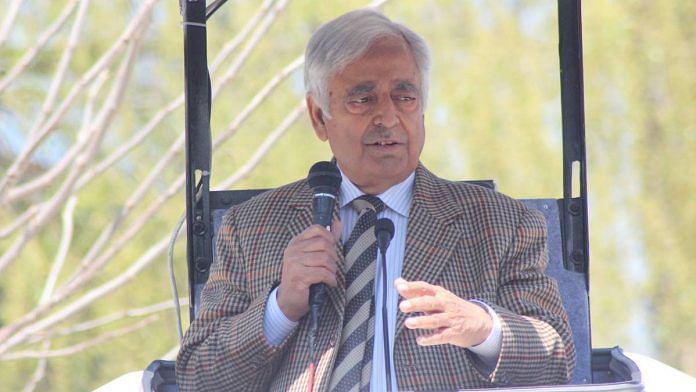Mufti Mohammad Sayeed, a two-time chief minister of Jammu & Kashmir, passed away this day three years ago.
New Delhi: Mufti Mohammad Sayeed was 53 years old, and just days into his tenure as India’s first Muslim home minister when his daughter Rubaiya, a 23-year-old medical intern, was abducted from Srinagar on 8 December 1989.
Her abductors, members of the Jammu & Kashmir Liberation Front (JKLF), wanted five fellow militants released from prison in exchange for her release. Against the advice of the then chief minister Farooq Abdullah, Sayeed managed to get the five militants released.
This decision is said to have helped catalyse the Kashmir militancy’s bloody 1990s chapter, and remains one of the defining points of Sayeed’s legacy.
Another was his knack for bold political moves, the last of which saw the founder of the Peoples Democratic Party (PDP) forge a tie-up with ideological opponent Bharatiya Janata Party (BJP) to form a government in the restive state.
Sayeed, two-time chief minister of Jammu & Kashmir, passed away on 7 January 2016, months before the killing of Hizbul Muahideen commander Burhan Wani in an encounter on 8 July thrust the Valley into a state of fresh turmoil.
The tie-up with the BJP has since collapsed, and Jammu & Kashmir remains on edge, with his own party hit by rebellion.
Three years after his death, Sayeed’s stated objective for forming the PDP, to write a new roadmap for Kashmir, appears elusive.
“Mufti Sayeed’s death was the biggest setback for the party,” said political analyst Noor Ahmed Baba. “In the process, the party has considerably weakened. Public image has also been damaged.”
Rise to prominence
Sayeed was born on 12 January 1936 in Bijbehara, Anantnag. He graduated in law from Srinagar’s Sri Pratap College, before pursuing a master’s at Aligarh Muslim University.
According to his profile on the Lok Sabha website – he was a two-time MP while a member of the Congress – he was a gardening enthusiast who enjoyed studying political history and literature.
He also loved golf, and reportedly harboured a dream to pitch Kashmir as a “golfing paradise” to tourists.
His affair with active politics began in the 1950s, and he first entered the state legislative assembly in 1962, aged all of 26.
Over the years, his political career spanned different parties – from the Democratic National Conference (DNC), a splinter group of the J&K National Conference (JKNC), to the Congress, the Janata Dal, and back to the Congress, before he formed the PDP in 1999.
By 1975, he had switched sides to the Congress. During ‘Sher-e-Kashmir’ Sheikh Abdullah’s final stint heading J&K, Sayeed is said to have emerged as Delhi’s man in the Valley.
“Basically, former Prime Minister Indira Gandhi was very suspicious of Shiekh even after the 1975 accord (which called for the continuation of Article 370, among other things) happened,” political commentator Noor-ul-Qamrain told ThePrint.
“So, she keep a tab on him through Mufti. He became the eyes and ears of New Delhi,” he added.
According to Qamrain, Mufti was the “blue-eyed boy” of the Congress in those days.
The 1980s saw the emergence of the second generation of Abdullahs as Farooq rode a sympathy wave in the wake of his father Sheikh Abdullah’s death to win the majority in the 1983 election.
However, a year later, the government was dismissed by the then governor Jagmohan after 13 JKNC MLAs defected to the Congress.
Qamrain said Sayeed was the architect of this rebellion in the Farooq Abdullah-led National Conference.
“Farooq’s brother-in-law Ghulam Mohammad Shah made a new government in the state,” he added, with reports suggesting the coup was supported by the Congress.
In 1986, Sayeed was made the union minister for tourism in the Rajiv Gandhi government. But ties frayed by the next year, when an accord between Rajiv Gandhi and Farooq to bring stability in Kashmir brought the latter back as chief minister.
Sayeed then quit the Congress just as V.P. Singh was sacked by the party for speaking out on the Bofors scandal.
When an anti-Congress coalition, the National Front, formed the government under V.P. Singh at the Centre in 1989, Sayeed became home minister.
The PDP
Mufti launched the PDP in 1999 when, according to Kashmir watchers, no one was ready to fight elections in that volatile time.
It was his own daughter Mehbooba Mufti, his successor as chief minister, who emerged as the foot soldier of the party and took the PDP door-to-door in the Kashmir Valley.
By opting for “the pen and inkpot” as the party symbol, Sayeed wanted to write a new roadmap for Kashmir where he would emerge as the accepted leader of masses.
Though he has openly sought to balance his identity as Kashmiri and Indian, both father and daughter came to be identified with a “soft-separatist” ideology.
In its maiden election in 2002, the PDP won 16 of the state’s 16 assembly seats, scoring 21 in 2008. In 2014, it emerged as the biggest player with 28 seats.
Also read: How students in terror-hit south Kashmir beat unrest & shutdowns to top Class 10 results
An earlier version of the report erroneously said in one mention that Mufti Mohammad Sayeed “died two years ago” though he passed away in 2016. The error is regretted.




Gardner, Golfer and Murderer – Why do all the writers of your propaganda news house miss the most critical piece of information?
The greatest murderer in the history of free India. The Kashmiri blood is on your hands. And this newspaper is a bhadwa.
Gentleman….LOL
A gentleman. I had great hopes when the coalition government was formed, but Mufti Saheb would have realised in the short time he headed it that the chemistry was just not there.